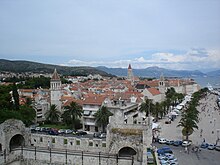This is an old revision of this page, as edited by Jesuislafete (talk | contribs) at 22:28, 8 June 2010 (→External links). The present address (URL) is a permanent link to this revision, which may differ significantly from the current revision.
Revision as of 22:28, 8 June 2010 by Jesuislafete (talk | contribs) (→External links)(diff) ← Previous revision | Latest revision (diff) | Newer revision → (diff)
Johannes Lucius (Template:Lang-la, Template:Lang-hr, Template:Lang-it; September, 1604 - January 11, 1679) was a historian from Dalmatia. His greatest and most famous work is De regno Dalmatiae et Croatiae (The Kingdom of Dalmatia and Croatia), which includes valuable historical sources, a bibliography and six historical maps.
Life and works
Johannes was son of Peter Lucius and Klara Divnić, born into a Trogir's noble Croatian family in Dalmatia, then controlled by Republic of Venice, and today a region of Croatia. After some schooling in his hometown, he went to Rome, where he spent two years, and then obtained his Ph.D. in ecclesiastical and civil law in the University of Padua. He returned to Trogir, and held various offices, but he returned to Rome in 1654. There he became a member of the Fraternity of Saint Jerome, and then its president. He participated in the work of many scientific academies of his age, and wrote to scientists from Dalmatia, Italy and Europe.
He wrote a number of historical works in Italian and Latin. His greatest and most famous work is De regno Dalmatiae et Croatiae (The Kingdom of Dalmatia and Croatia). The book was published after the war of Candia, a critical moment for the Republic of Venice. In his book Lucius pointed out the difference between the Romance and Slavic Dalmatia, the habits of the people and the cultural borderlines.
It was first printed in Amsterdam in 1666. This book provides an overview of both, the history of Dalmatia and history of Croatia, from the prehistory to the 15th century. While his predecessors and contemporaries used suppositions as much as facts, Lucius founded his estimates on genuine sources. At the end of the book, he included certain valuable historical sources and a bibliography with his comments. The book had six historical maps. One of maps, the historical map Illyricum hodiernum (today's Illyria) was dedicated by Joannes Blaeu, Lucius' publisher, to the Croatian ban Petar Zrinski . Since everyone was looking up to antiquity, the Zrinski believed their ancestors were Roman aristocrats. Lucius showed them, that their roots reached back to the famous medieval dukes of Šubićs noble family from Bribir.
Lucius participated in the dispute about the authenticity of the text of Trimalchio's Banquet by the Roman satirist Petronius, which had been found in Trogir.
He also published the history of his home town in Memoriae istoriche di Tragurio, ora detto Trau (Trogir in Historical Literature; 1673). He also published a book of Roman inscriptions from Dalmatia, including the inscriptions collected by the famous Croatian poet and writer Marko Marulić. Shortly before his death, Lucius prepared the Statute of Trogir for printing.
Lucius was never married. He resided in Rome until his death, and was buried there, in the Church of St Jerome. A monument was erected to his memory in 1740.
Significance
Johannes Lucius was the first Dalmatian historian who critically examined and used historical sources: documents and chronicles, inscriptions and last wills. His historical methodology is far above his time.
He wrote to many famous people from Republic of Ragusa (Dubrovnik), especially Stefano Gradi, the head of the Vatican Library. His numerous letters, revealing him as a man of integrity and a skillful writer, are a valuable fresco of the conditions of his time.
Lucius' work, written in a lapidary and clear style, based on critical considerations, is the cornerstone of the modern historiography about Dalmatia. Today in Croatia, Lucius is considered the father of modern cotemporary Croatian historiography.
Works
The following are his principal published works:
- De Regno Dalmatiae et Croatiae libri sex (6 vols., Venice, 1673);
- Inscriptiones Dalmaticae, notae ad memoriale Pauli de Paulo, notae ad Palladium Fuscum, addenda vel corrigenda in opere de regno Dalmatiae et Croatiae, variae lectiones Chronici Ungarici manuscripti cum editis (Venice, 1673).
References
| This article does not cite any sources. Please help improve this article by adding citations to reliable sources. Unsourced material may be challenged and removed. Find sources: "Johannes Lucius" – news · newspapers · books · scholar · JSTOR (May 2010) (Learn how and when to remove this message) |